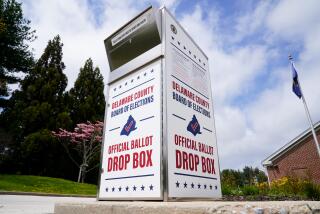Switching to a Tailor-Made Ad Campaign
Grasping for the smallest slivers of voting blocs in pivotal states, Democratic advertising strategists are releasing a series of television commercials criticizing Texas Gov. George W. Bush with arguments written for specific states and even specific cities.
After soaking the airwaves in 17 battleground states from Washington to Maine with generic ads about patients’ rights or education over the last 15 weeks, the Democratic National Committee started “selective audience appeals” this week in some of the media markets most critical to the election.
One new commercial, which began airing Wednesday in Seattle, superimposes smog over the city’s skyline and landmark Space Needle as an announcer warns, “Last year, Houston overtook Los Angeles as America’s smoggiest city. Now take a deep breath and imagine Seattle with Bush’s Texas-style environmental regulation. George Bush: Before he talks about cleaning up Washington, maybe he should clean up Texas.”
In another commercial, the party is targeting low-wage workers in Louisiana and Arkansas with an ad attacking Bush’s “inaction” in raising his state’s minimum wage.
Such local targeting also decides which ads not to run: Democrats said they aren’t airing a new spot attacking Bush’s career as an oil man in oil-dependent Louisiana, for example.
The release of the new ads shows how party and campaign strategists view the nation--not as a whole or even as 50 separate states but as a mix of 210 television media markets where the candidates’ messages can vary depending on whose airwaves are carrying it.
Analysts said the unusual technique, while allowing the parties to market their candidates with surgical precision, also carried a measure of risk if a message designed for one voting bloc is exposed to another.
For example, the minimum-wage spot could be used to reach out to Louisiana oil rig workers who disapprove of Gore’s attacks on Bush’s oil ties.
“If you’re a candidate engaging in selective audience appeals, you can’t assume only that audience is going to hear the message,” said Darrell West, a Brown University professor who studies political ad strategy. “You don’t want to be seen as pandering to a particular area.”
Over the last two presidential campaigns, candidates have been buying less and less air time on the national broadcast networks because they say it is more cost efficient to buy ad time market-by-market in key states. But until this point in the campaign, the two parties have rotated the same ads across as many as 20 states at one time.
Still, both parties have tried such localized ads in previous campaigns. In the 1988 election, for example, Republicans aired an ad in California to spotlight Democratic nominee Michael S. Dukakis’ support for oil drilling off his state’s coast. “And now Michael Dukakis says he wants to do for America what he’s done for Massachusetts. California can’t take that risk,” an announcer said in the spot. A variation of the spot ran in New Jersey.
Gore campaign officials said they also plan to target ads to specific regions.
Bush campaign and Republican Party strategists said they have not decided whether they will be shaping ads specifically to appeal to different markets. Republicans, however, did put extra money behind prescription drug ads airing in Florida, which has a large population of senior citizens.
A senior Bush aide said the campaign will tailor radio ads but suggested that crafting market-specific spots for television isn’t practical.
“They’re not voting for mayor,” the aide said. “It’s more than just about a local picture.”
“If the spot serves to localize an issue that is already very important in your campaign, it can be effective,” said Terry Holt, a GOP spokesman. “If you’re trying specifically to pander to a group of people, that can be an enormous waste of time. Generally speaking, voters want to see what you’re going to do for the country.”
More to Read
Get the L.A. Times Politics newsletter
Deeply reported insights into legislation, politics and policy from Sacramento, Washington and beyond. In your inbox three times per week.
You may occasionally receive promotional content from the Los Angeles Times.








